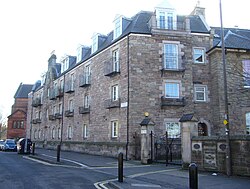
Eliza Maud "Elsie" Inglis was a Scottish medical doctor, surgeon, teacher, suffragist, and founder of the Scottish Women's Hospitals. She was the first woman to hold the Serbian Order of the White Eagle.

Sophia Louisa Jex-Blake was an English physician, teacher, and feminist. She led the campaign to secure women access to a university education, when six other women and she, collectively known as the Edinburgh Seven, began studying medicine at the University of Edinburgh in 1869. She was the first practising female doctor in Scotland, and one of the first in the wider United Kingdom of Great Britain and Ireland; a leading campaigner for medical education for women, she was involved in founding two medical schools for women, in London and Edinburgh, at a time when no other medical schools were training women.
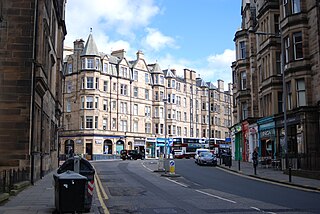
Bruntsfield is a largely residential area around Bruntsfield Place in Southern Edinburgh, Scotland. In feudal times, it fell within the barony of Colinton.

The Elsie Inglis Memorial Maternity Hospital was a maternity hospital in Holyrood, Edinburgh, Scotland.
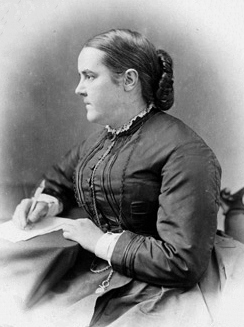
The Edinburgh Seven were the first group of matriculated undergraduate female students at any British university. They began studying medicine at the University of Edinburgh in 1869 and, although the Court of Session ruled that they should never have been admitted, and they did not graduate or qualify as doctors, the campaign they fought gained national attention and won them many supporters, including Charles Darwin. Their campaign put the demands of women for a university education on the national political agenda, and eventually resulted in legislation to ensure that women could be licensed to practice medicine in 1876.
The London School of Medicine for Women (LSMW) established in 1874 was the first medical school in Britain to train women as doctors. The patrons, vice-presidents, and members of the committee that supported and helped found the London School of Medicine for Women wanted to provide educated women with the necessary facilities for learning and practicing midwifery and other branches of medicine while also promoting their future employment in the fields of midwifery and other fields of treatment for women and children.
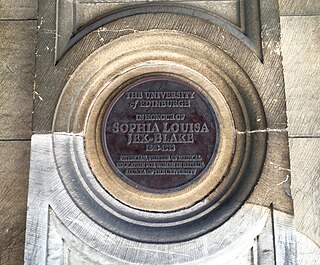
The Edinburgh School of Medicine for Women was founded by Sophia Jex-Blake in Edinburgh, Scotland, in October 1886, with support from the National Association for Promoting the Medical Education of Women. Sophia Jex-Blake was appointed as both the director and the dean of the school. The first class of women to study at the Edinburgh School of Medicine for Women consisted of eight students, the youngest of whom was nineteen years of age. Throughout its twelve years in operation, the school struggled to find financial funding to remain open. A rival institution, the Edinburgh College of Medicine for Women, set up by the Scottish Association for the Medical Education of Women whose leading members included John Inglis, the father of Elsie Inglis, attracted several students of Jex-Blake, including Martha Cadell and Grace Cadell. St Mungo's College and Queen Margaret College in Glasgow also accepted women medical students and when the Scottish universities began to do so the Edinburgh School of Medicine could no longer compete. The school closed in 1898. Over the twelve years of its operation, the Edinburgh School of Medicine provided education to approximately eighty female students. Of those eighty students, thirty-three completed the full course of medical training at the Edinburgh School while many others chose to finish their education at outside institutions.

The Elizabeth Garrett Anderson and Obstetric Hospital and its predecessor organisations provided health care to women in central London from the mid-Victorian era. It was named after Elizabeth Garrett Anderson, one of Britain's first female physicians, and its work continues in the modern Elizabeth Garrett Anderson wing of University College Hospital, part of UCLH NHS Foundation Trust.

The Edinburgh Royal Maternity and Simpson Memorial Pavilion was a maternity hospital in Lauriston, Edinburgh, Scotland. Its services have now been incorporated into the Royal Infirmary of Edinburgh at Little France.

Jessie MacLaren MacGregor was one of the first women to be awarded an MD from the University of Edinburgh in 1899. Along with Elsie Inglis she was instrumental in setting up the Muir Hall of Residence for Women Students in Edinburgh, and the Hospice, a nursing home and maternity hospital for poor women.

Alexandra Mary Chalmers Watson CBE,, known as Mona Chalmers Watson, was a British physician and head of the Women's Army Auxiliary Corps. The first woman to receive an MD from the University of Edinburgh, she helped found the Elsie Inglis Hospital for Women, was the first president of the Edinburgh Women's Citizen Association, a staff physician and later senior physician at the Edinburgh Hospital and Dispensary for Women and Children, and co-edited the Encyclopaedia Medica with her husband, Douglas Chalmers Watson. At the time of her death in 1936, she was president of the Medical Women's Federation, having been elected May 1935.
Helen de Lacey Evans was the fifth member of the Edinburgh Seven, a group of women who enrolled at the University of Edinburgh in 1869, and who sought to qualify as physicians. She married the editor of TheScotsman, Alexander Russel and was mother to the suffragist and feminist campaigner Helen Archdale.
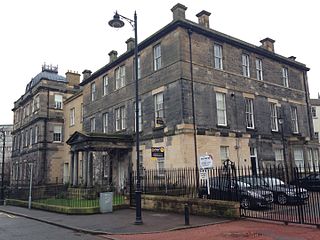
Leith Hospital was situated on Mill Lane in Leith, Edinburgh, and was a general hospital with adult medical and surgical wards, paediatric medical and surgical wards, a casualty department and a wide range of out-patient services. It closed in 1987.
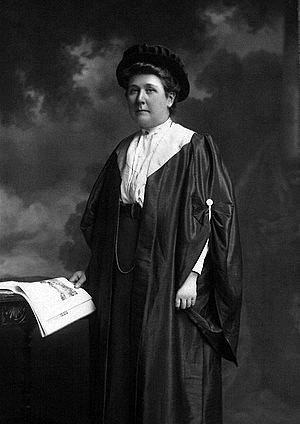
Grace Ross Cadell was a Scottish medical doctor and suffragist, and one of the first group of women to study medicine in Scotland and qualify.

The Edinburgh College of Medicine for Women was established by The Scottish Association for the Medical Education of Women whose leading members included John Inglis, the father of Elsie Inglis. Elsie Inglis went on to become a leader in the suffrage movement and found the Scottish Women's Hospital organisation in World War I, but when the college was founded she was still a medical student. Her father, John Inglis, had been a senior civil servant in India, where he had championed the cause of education for women. On his return to Edinburgh he became a supporter of medical education for women and used his influence to help establish the college. The college was founded in 1889 at a time when women were not admitted to university medical schools in the UK.

Dr William RussellFRCPE LLD, was a Scottish pathologist and physician who became Professor of Medicine at the University of Edinburgh and president of the Royal College of Physicians of Edinburgh. He was the first to describe the cellular inclusion particles known as Russell bodies. He was an early supporter of medical education for women.

Dr Elizabeth Pace was a Scottish medical doctor, suffragist and advocate for women's health and women's rights.
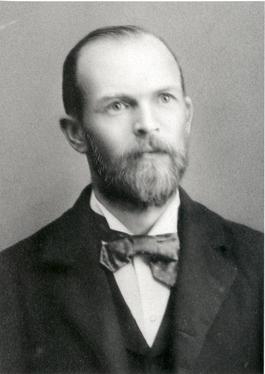
William Keiller was a Scottish born anatomist who trained in anatomy at the Edinburgh Extramural School of Medicine and was appointed as the first Professor of Anatomy at the University of Texas Medical Branch (UTMB) at Galveston, a post he held for 40 years. He served as Dean of the UTMB Medical School and as President of the Texas Medical Association. Many of his anatomical drawings and paintings are preserved and displayed at the Blocker History of Medicine collection at UTMB Moody Medical Library.
Helen Millar Lowe was a Scottish accountant, charity worker and activist. She was one of the first women to become chartered accountants in Scotland, and conducted a successful campaign to ensure that the Bruntsfield Hospital for Women and the Elsie Inglis Memorial Maternity Hospital in Edinburgh remained staffed exclusively by qualified female medical professionals.

Ruth Nicholson FRCOG was an English obstetrician and gynaecologist who served as a surgeon in the Scottish Women's Hospital at Royaumont, France during the First World War. For this work she was awarded the Croix de Guerre and the Médaille d’Honneur des Épidémies by the French government. After the war she specialised in obstetrics and gynaecology as Clinical Lecturer and Gynaecological Surgeon at the University of Liverpool with consultant appointments at Liverpool hospitals. She was a founder member of the Royal College of Obstetricians and Gynaecologists in 1929, being elevated to fellow of the college in 1931.
